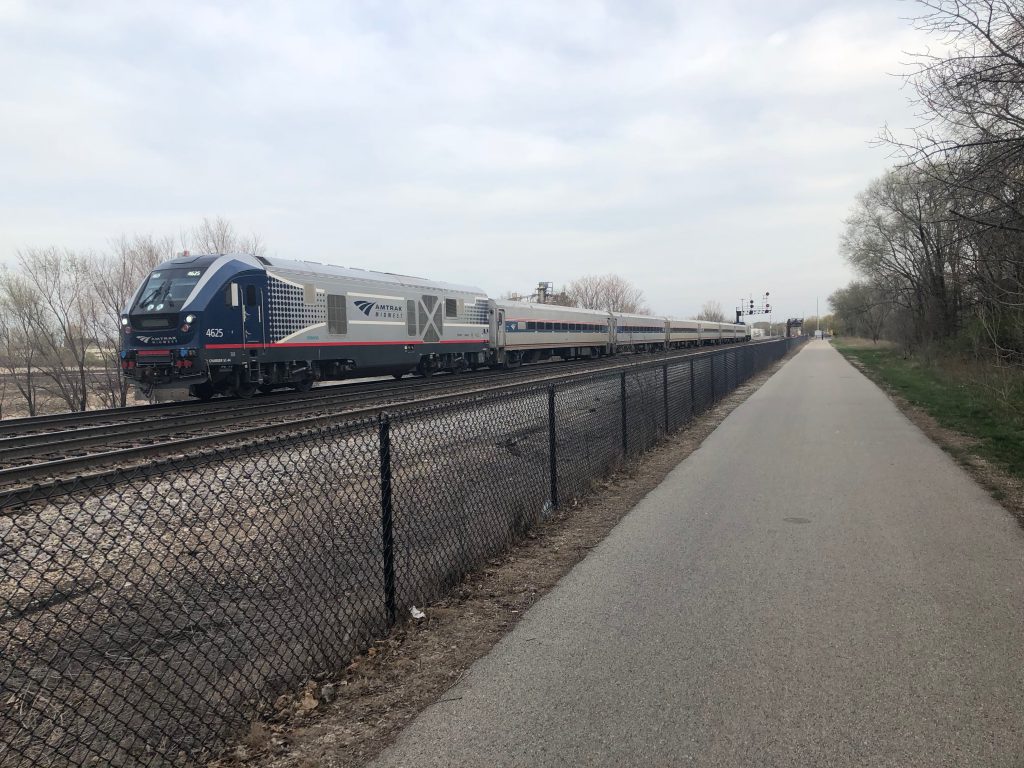Illinois Kills Hiawatha Expansion
Illinois governor kills $195 million plan to expand service between Milwaukee and Chicago.
The administration of newly-elected Illinois Democratic Governor J.B. Pritzker has killed a plan to expand Amtrak Hiawatha service between Chicago and Milwaukee from seven to 10 daily roundtrips.
The Illinois Department of Transportation’s acting secretary Omer Osman told two Illinois state senators that the $195 million plan it had jointly engineered with the Wisconsin Department of Transportation (WisDOT) would not be happening. “IDOT will not agree to the freight train holding tracks in either Glenview or Lake Forest, and you have my commitment that IDOT will not be moving forward seeking federal support for this project,” said Osman in a letter dated May 2nd.
WisDOT announced in March that the line had record ridership in 2018, with 858,000 riders representing a 3.6 percent increase over 2017 ridership. Ridership has doubled since 2003. The train, which runs between Milwaukee and Chicago with stops at General Mitchell International Airport, Sturtevant and Glenview, is the busiest passenger train line in the Midwest and one of the 10 busiest routes in the Amtrak system.
In June, Glenview’s Deputy Village Manager Don Owen told Alexandra Kukulka of the Chicago Tribune: “They are significantly changing how freight trains impact Glenview. Instead of purposefully planning for them to come through our town at 30 to 40 miles an hour and get through our town quickly … instead, they’re planning on building a two-mile-long holding track and stopping freight trains and creating a mini freight yard in Glenview.” The village would like to see a 30-mile freight bypass built.
Glenview was joined in opposing the project by nearby Lake Forest (population 19,375). On the one hand Lake Forest opposes the expansion and its leaders were glad that a proposed additional siding (where a train can be parked) to be created in Lake Forest was dropped by commuter rail agency Metra. On the other hand Lake Forest officials have advocated to add a Hiawatha stop in their city, but only under the current (non-expanded) system. (A study estimated this new stop would add approximately four minutes to the 86-mile, 89-minute Hiawatha trip.)
The opposition to the proposal at the state level started under Republican Governor Bruce Rauner. In September 2018, shortly before the gubernatorial election, Rauner’s administration said it was pausing further work on the project’s engineering.
“We have heard loud and clear the concerns expressed by Lake Forest and Glenview,” Rauner said. “We listened to you.”
Before the delay, Arun Rao, Passenger Rail Implementation Manager for the Wisconsin Department of Transportation, told a Milwaukee Common Council committee in February that expanded service could begin running at 2023 at the earliest. The study has been underway since 2013.
Because it would be federally funded, the project’s environmental study is required to get a Finding of No Significant Impact from the Federal Transit Administration.
Project Cost Details
“Why does it cost $200 million to add three trains? That is a common sense question until you read your study,” Alderman Robert Bauman said in a February 2018 meeting discussing the project.
“When you add an 80 miles-per-hour passenger rail to a corridor it takes up a lot of capacity,” Bauman explained. Operating in the corridor today, which is owned by Canadian Pacific in Wisconsin and the publicly-owned Metra commuter railroad in Illinois, are 65 Metra trains, 25 freight trains and 16 Amtrak trains (the Hiawatha and Empire Builder).
Adding a car to the trains, which currently seat 408 passengers, is prohibitively expensive because an additional conductor would be contractually required.
The federal government could pay for up to 50 percent of the project’s cost. To operate the line today, Wisconsin pays for 75 percent of the cost, with Illinois paying 25 percent. Hiawatha revenue pays for 75 percent of the service’s cost; a cost-recovery ratio far ahead of the Milwaukee County Transit System (26 percent) or the streetcar (estimated at 20 percent). Final design, which would start after the Federal Railroad Administration signs off on the plan, could lower the project’s cost through the process of formal engineering work.
If you think stories like this are important, become a member of Urban Milwaukee and help support real independent journalism. Plus you get some cool added benefits, all detailed here.
Transportation
-
MCTS Adds 28 New Buses
 Jul 13th, 2024 by Graham Kilmer
Jul 13th, 2024 by Graham Kilmer
-
MCTS Designing New Bus Shelters
 Jul 10th, 2024 by Graham Kilmer
Jul 10th, 2024 by Graham Kilmer
-
MCTS Updates RNC Bus Detours To Better Serve Downtown, Riders
 Jul 9th, 2024 by Jeramey Jannene
Jul 9th, 2024 by Jeramey Jannene























This would seem to be an argument for reviving the MRK proposal that would connect Milwaukee to Chicago, through Racine and Kenosha, and the Metra line that ends in Kenosha.
There should be a Hiawatha stop at Lake Forest, but it should replace today’s Glenview stop, not be an additional stop because Lake Forest would connect better to Metra’s commuter rail service.
The Hiawatha shares track with Metra’s “Milwaukee North” line which runs 50 miles from Fox Lake Illinois to Chicago Union Station (the same station Amtrak uses). That line runs on separate track for the first 20 miles, joining up with Amtrak just north of Lake Forest.
Of 22 Metra stations on this line, Amtrak serves only two (Glenview and Union Station). If somebody wants to travel between Wisconsin and any of the other 20 stops, they must change trains at Glenview.
But most of the 22 Metra stations are north of Glenview which means many people are forced to double back and travel up to 20 extra miles. Moving the Amtrak/Metra transfer station 10 miles north from Glenview to Lake Forest (just south of where the two lines diverge) would eliminate this extra time and distance.
Moving the Amtrak stop from Glenview to Lake Forest would not increase total running time at all.